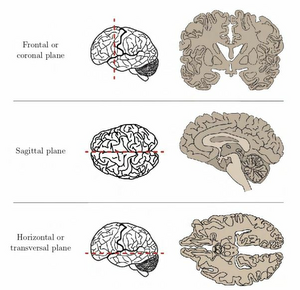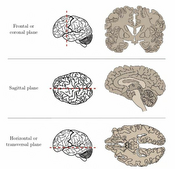Information
- Publication Type: Master Thesis
- Workgroup(s)/Project(s): not specified
- Date: 2022
- TU Wien Library:
- Open Access: yes
- First Supervisor: Eduard Gröller

- Pages: 125
- Keywords: brain connectivity visualization, Node-Link Diagram
Abstract
Technological advances have dramatically expanded our ability to collect data of neural connectivity in the brain and apply this data in the field of connectomics. The focus of research is thus increasingly shifting towards the analysis of this complex data. Many applications visualize neurological data in three-dimensional space. However, these require interactivity to view hidden data and are not always applicable. To support neuroscientific research we present Spatial-Data-Driven Layouts, a novel web-tool to visualize neuronal networks of multiple species in two-dimensional space. Our method is data-driven and is therefore independent of species or perspective. We generate node-link diagrams where nodes represent brain regions, while the edges correspond the connectivity. To realize this data-driven approach we apply Parcellation-derived Connectivity, generated from brain atlases in combination with a standard force-directed graph layout algorithm. We provide further guidance by visually encoding anatomical context of the underlying brain hierarchy. Colored parcellations in the background encapsulate and cluster nodes that belong to the same super-regions. Additionally the background provides an overall shape, similar to the brain and is independent of the graph’s completeness, facilitating the comparison of sub-networks with each other as well as with the entire network. The background is customizable in terms of anatomical details to reflect either the anatomical size or the number of connections per region.We conduct case studies for two species, mouse and human, to validate our visualizations and show that the spatial distribution of nodes reflects the anatomy of the brain. Nodes are adjacent to each other if they also represent neighboring regions in the reference space.The results provided by Spatial-Data-Driven Layouts are evaluated in a web-based user study involving domain experts in neuroscience, computer science, computational science, bioinformatics, and computational biology. Evaluating the studies for two different species, mouse and human, shows that our methodology can be applied data-driven and species-independent. The feedback obtained from the experts indicates clear potential.Spatial-Data-Driven Layouts quickly and easily recreate illustrations in literature that usually are created with a great deal of effort. Added context in sub-networks to preserve the overall shape of the brain and to make those networks comparable to each other, wasconsidered very useful. Spatial-Data-Driven Layouts is a novelty in the visualization of neuronal circuits of the Drosophila melanogaster larval brain and considered a first good step in this direction.In the future, we plan to extend the application with interactivity to provide neuroscientists with an intuitive representation of their data. The customization of brain regions, connectivity, as well as details of the layout via parameters, can be adapted to their interests. In addition, we aim to improve neuron-level visualization and visual encoding of the Drosophila larval network graphs to provide a more detailed representation of circuits.
Additional Files and Images
Additional images and videos
Additional files
Weblinks
BibTeX
@mastersthesis{wissmann-2022-alb,
title = "Anatomy-Driven Layouting for Brain Network Visualization",
author = "Monika Wi{\ss}mann",
year = "2022",
abstract = "Technological advances have dramatically expanded our
ability to collect data of neural connectivity in the brain
and apply this data in the field of connectomics. The focus
of research is thus increasingly shifting towards the
analysis of this complex data. Many applications visualize
neurological data in three-dimensional space. However, these
require interactivity to view hidden data and are not always
applicable. To support neuroscientific research we present
Spatial-Data-Driven Layouts, a novel web-tool to visualize
neuronal networks of multiple species in two-dimensional
space. Our method is data-driven and is therefore
independent of species or perspective. We generate node-link
diagrams where nodes represent brain regions, while the
edges correspond the connectivity. To realize this
data-driven approach we apply Parcellation-derived
Connectivity, generated from brain atlases in combination
with a standard force-directed graph layout algorithm. We
provide further guidance by visually encoding anatomical
context of the underlying brain hierarchy. Colored
parcellations in the background encapsulate and cluster
nodes that belong to the same super-regions. Additionally
the background provides an overall shape, similar to the
brain and is independent of the graph’s completeness,
facilitating the comparison of sub-networks with each other
as well as with the entire network. The background is
customizable in terms of anatomical details to reflect
either the anatomical size or the number of connections per
region.We conduct case studies for two species, mouse and
human, to validate our visualizations and show that the
spatial distribution of nodes reflects the anatomy of the
brain. Nodes are adjacent to each other if they also
represent neighboring regions in the reference space.The
results provided by Spatial-Data-Driven Layouts are
evaluated in a web-based user study involving domain experts
in neuroscience, computer science, computational science,
bioinformatics, and computational biology. Evaluating the
studies for two different species, mouse and human, shows
that our methodology can be applied data-driven and
species-independent. The feedback obtained from the experts
indicates clear potential.Spatial-Data-Driven Layouts
quickly and easily recreate illustrations in literature that
usually are created with a great deal of effort. Added
context in sub-networks to preserve the overall shape of the
brain and to make those networks comparable to each other,
wasconsidered very useful. Spatial-Data-Driven Layouts is a
novelty in the visualization of neuronal circuits of the
Drosophila melanogaster larval brain and considered a first
good step in this direction.In the future, we plan to extend
the application with interactivity to provide
neuroscientists with an intuitive representation of their
data. The customization of brain regions, connectivity, as
well as details of the layout via parameters, can be adapted
to their interests. In addition, we aim to improve
neuron-level visualization and visual encoding of the
Drosophila larval network graphs to provide a more detailed
representation of circuits.",
pages = "125",
address = "Favoritenstrasse 9-11/E193-02, A-1040 Vienna, Austria",
school = "Research Unit of Computer Graphics, Institute of Visual
Computing and Human-Centered Technology, Faculty of
Informatics, TU Wien",
keywords = "brain connectivity visualization, Node-Link Diagram",
URL = "https://www.cg.tuwien.ac.at/research/publications/2022/wissmann-2022-alb/",
}

 Master thesis
Master thesis


